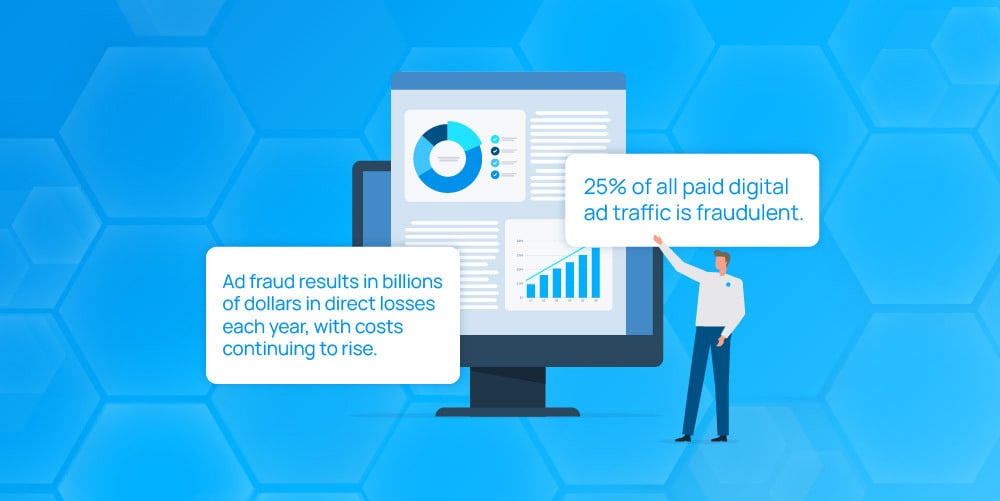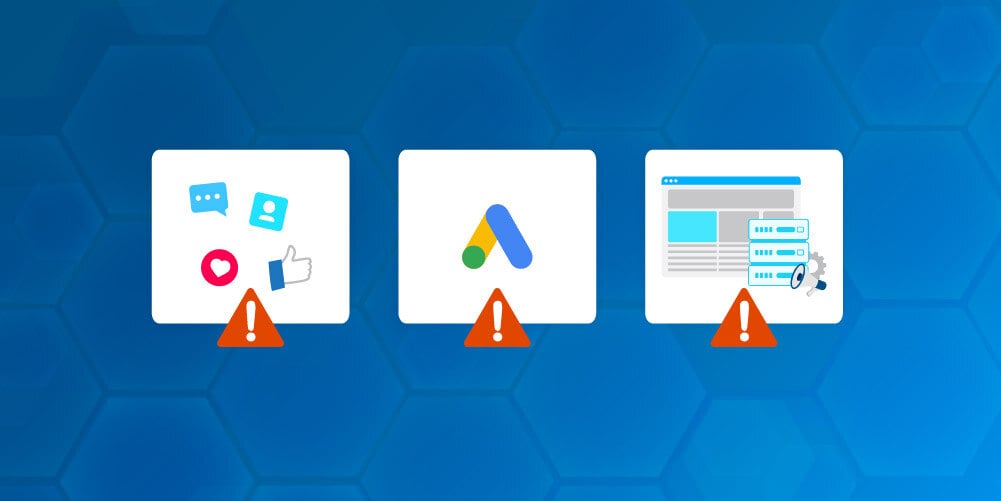Surprising Ad Fraud Statistics
Surprising Ad Fraud Statistics

TL;DR: This final chapter of our guide highlights key statistics revealing the significant impact of ad fraud, emphasizing its growth and the necessity for advanced countermeasures.
- Financial Impact: Estimated global loss from ad fraud exceeded $140 billion in 2024; projected to rise.
- Vulnerable Platforms: High fraud rates in affiliate marketing (45%) and programmatic advertising (50%).
- Mobile and Click Fraud: Significant issues in mobile ads and PPC campaigns, with considerable financial losses.
- Seasonal and Regional Variations: Peaks during holiday season; significant regional differences in fraud types and techniques.
Welcome to the final chapter of our comprehensive guide on ad fraud. Over the course of this series, we’ve navigated the murky waters of digital deception, uncovering the tactics and impacts of fraudulent advertising practices.
This conclusion aims to highlight the always-evolving nature of ad fraud through startling statistics that just might surprise you. These figures not only reflect the current state of ad fraud but also underscore the critical need for vigilance and sophisticated countermeasures to fight against fraud in the future.
The Magnitude of Ad Fraud
As you’ve seen through this guide, ad fraud is a formidable foe. As businesses allocate more of their budgets towards digital platforms, the opportunity and incentive for fraudsters continue to escalate.
Just consider these digital ad fraud statistics.
Stat #1: Total Financial Loss Globally
Nailing down the global cost of ad fraud is challenging. There’s no telling how much ad fraud is slipping by especially as more sophisticated tactics aim to avoid detection.
Moreso, when fraud losses are projected most analysts only focus on the hard costs – the money spent on ad space and money lost to fraud. But there’s more to these losses and the hidden costs can add up fast. The resources spent on creating campaigns, skewed data undermining marketing decisions, increased customer acquisition costs, missed opportunities for re-targeting, wasted resources pursuing fraudulent visitors, damaged brand reputation, destructive buyer’s journey, and back end fees are just the tip of the iceberg.
By our estimates, ad fraud cost advertisers over $140 billion in 2024 – with this number set to only increase drastically in the coming years. According to our data and the steep rise in ad fraud over the last few years, we project that ad fraud will be at a staggering $200 billion by the end of 2028. Yes! A shockingly high number, we know!

Stat #2: Year-Over-Year Growth
Ad fraud is escalating, not diminishing.
Global ad fraud trends like the use of artificial intelligence and sophisticated bots point to it becoming easier for fraudsters to drive invalid traffic on a large scale.
 By some projections, 80% of total ad spending will come from digital sources in 2029. To put that in perspective, that could be well over $950 billion spent on digital ads. That number takes into account the forecasted growth of global digital marketing over the next five years.
By some projections, 80% of total ad spending will come from digital sources in 2029. To put that in perspective, that could be well over $950 billion spent on digital ads. That number takes into account the forecasted growth of global digital marketing over the next five years.
We conservatively project that by this time, 25% of the global marketing digital ad spend will be fraud. That is well over 200 billion dollars lost to bots and bad actors.

Digital Platforms and Their Vulnerabilities
Fraud can happen anywhere, but these statistics on digital ad fraud shine some light on the platforms where it’s most prevalent.
Stat #3: Most Vulnerable Digital Platforms
Not all digital platforms are created equal. Some are simply more susceptible to ad fraud than others, largely due to their high traffic volumes and complex ad delivery mechanisms.
Affiliate marketing and programmatic advertising are highly susceptible to fraud, with estimated fraud rates of 45% and 50%, respectively based on our data that has been collected over the course of many years. No platform is immune. According to our research, Google and Facebook also have an estimated 5%-10% fraud rate.
Stat #4: Percentage of Digital Ads Affected
It’s not a matter of if your digital ads are affected by fraud, it’s a matter of how much. We know that on average $1 in every $4 spent on digital ads is lost to fraud.

Mobile and Click Fraud Specifics
Mobile platforms and click-based advertising are significant battlegrounds when it comes to fighting ad fraud.
Stat #5: Mobile Ad Fraud Statistics
More media dollars are being spent on mobile ads. According to eMarketer, spending on in-app advertising and mobile web ad spending will account for nearly two-thirds of digital ad dollars in 2024.
More mobile ads lead to more mobile fraud.
This means it’s time to shore up your defenses. Mobile ad fraud includes methods like SDK spoofing, click injection, and fake app installs. Understanding your risk level and implementing the right solutions can help you fight against these threats.
Stat #6: Click Fraud Rates
Click fraud, one of the more straightforward ways to falsify ad impressions, is also costly. This practice directly impacts pay-per-click campaigns (PPC), one of the most common advertising models.
While it’s hard to find an exact number, current click fraud statistics that this type of advertising fraud could affect anywhere from 10% to 20% of all PPC campaigns. This translates to billions of dollars in wasted ad spend each year.

Trends and Patterns in Ad Fraud
It’s true that ad fraud is always changing. Not only does it evolve with technology, but there’s also seasonality involved. These surprising ad fraud statistics unveil trends that can help you protect your ad budgets throughout the year.
Stat #7: Seasonal Peaks in Ad Fraud
The holidays are a busy time for businesses, consumers, and fraudsters. As businesses ramp up their advertising budget for the season, there’s more opportunity for bad actors to start profiting from their online ads.
Most experts agree that ad fraud spikes during the holiday season — typically October through December.

Stat #8: Industries Most Affected
No industry is immune from ad fraud, but some are more affected than others. For instance, we’ve found that education, finance, and real estate are all the most at risk for click fraud. As are legal businesses and the health and medical industry.
Geographical Insights
Ad fraud is a global issue, but some digital ad fraud statistics show us how it can vary from region to region.
Stat #9: Countries with Highest Rates of Ad Fraud
According to our estimates, North America has the largest fraudulent transaction value of any regional market. It accounts for nearly half (42%) of global ad fraud.
It’s important to understand the bigger picture of ad fraud as well. The U.S. and China, being major markets for digital advertising spend, attract significant fraudulent activities aiming to exploit their large-scale digital campaigns. While other countries, such as Russia or Vietnam, are hotbeds for sophisticated cyber-attacks and click farms respectively.
Stat #10: Regional Differences in Ad Fraud Types
Types of ad fraud can also vary by region. Though fraudsters have a global reach, we often see these trends:
- North America experiences sophisticated botnets that mimic human behavior to generate fake ad clicks and impressions.
- Asia, particularly Southeast Asia, has high instances of click spamming and ad stacking due to the rapid growth of mobile markets and less stringent regulations.
- Europe, with its strong data protection laws like GDPR, faces unique challenges such as sophisticated consent manipulation schemes aiming to bypass privacy settings for ad targeting.
- Latin America experiences a significant amount of domain spoofing, where fraudsters mimic legitimate publishers to siphon off ad revenues.
With the rising complexity and cost of ad fraud, businesses need a robust solution to protect their advertising budgets. Anura keeps a pulse on the digital landscape to help your business identify and block fraud from messing with your metrics and bottom line.
By choosing Anura, businesses can secure their digital advertising efforts, maintain the integrity of their data, and ultimately, enhance the effectiveness of their advertising spend. Experience the power of Anura and discover just how much fraud you have with a free trial!
TALK TO AN EXPERT
How much of your traffic is fake?
Experience the power of Anura and discover just how much fraud you have with a free trial!


